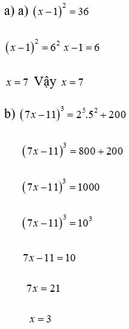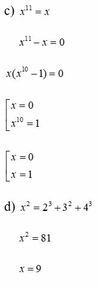Tìm x ∈ N biết:
a) x - 1 2 = 36
b) 7 x - 11 3 = 2 5 . 5 2 + 200
c) x 11 = x
d) x 2 = 2 3 + 3 2 + 4 3
e) 2 . x 3 3 2 = 48
f) ( 2 x + 1 ) 3 = 125
Hãy nhập câu hỏi của bạn vào đây, nếu là tài khoản VIP, bạn sẽ được ưu tiên trả lời.





Bài 1:
a: Số phần tử của tập hợp A là:
50-11+1=40
b: Số phần tử của tập hợp B là:
\(\left(100-0\right):10+1=11\)
c: Tập hợp C có 1 phần tử
d: Tập hợp D có : \(\left(31-5\right):2+1=14\)
e: Tập hợp E có 5 phần tử
f: Tập hợp F có vô số phần tử

\(a,\dfrac{3}{4}x-\dfrac{7}{12}=\dfrac{5}{6}-\dfrac{2}{3}\\ \Rightarrow\dfrac{3}{4}x-\dfrac{7}{12}=\dfrac{1}{6}\\ \Rightarrow\dfrac{3}{4}x=\dfrac{1}{6}+\dfrac{7}{12}\\ \Rightarrow\dfrac{3}{4}x=\dfrac{3}{4}\\ \Rightarrow x=\dfrac{3}{4}:\dfrac{3}{4}\\ \Rightarrow x=1\\ b,\dfrac{-5}{x}=\dfrac{20}{28}\\ \Rightarrow\dfrac{-5}{x}=\dfrac{5}{7}\\ \Rightarrow\dfrac{-5}{x}=\dfrac{-5}{-7}\\ \Rightarrow x=-7\\ c,2\dfrac{1}{3}:x=7\\ \Rightarrow\dfrac{7}{3}:x=7\\ \Rightarrow x=\dfrac{7}{3}:7\\ \Rightarrow x=\dfrac{1}{3}\)
\(d,\dfrac{-105}{12}< x< \dfrac{20}{7}\Rightarrow x\in\left\{-8;-7;...;2\right\}\)
a: \(\Leftrightarrow x\cdot\dfrac{3}{4}=\dfrac{3}{4}\)
hay x=1
b: \(\Leftrightarrow x=\dfrac{-28\cdot5}{20}=-7\)
c: \(\Leftrightarrow x=\dfrac{7}{3}:7=\dfrac{1}{3}\)
d: \(\Leftrightarrow-8< x< 3\)
hay \(x\in\left\{-7;-6;-5;-4;-3;-2;-1;0;1;2\right\}\)

a)
\(\begin{array}{l}x:{\left( {\frac{{ - 1}}{2}} \right)^3} = - \frac{1}{2}\\x = - \frac{1}{2}.{\left( {\frac{{ - 1}}{2}} \right)^3}\\x = {\left( {\frac{{ - 1}}{2}} \right)^4}\\x = \frac{1}{{16}}\end{array}\)
Vậy \(x = \frac{1}{{16}}\).
b)
\(\begin{array}{l}x.{\left( {\frac{3}{5}} \right)^7} = {\left( {\frac{3}{5}} \right)^9}\\x = {\left( {\frac{3}{5}} \right)^9}:{\left( {\frac{3}{5}} \right)^7}\\x = {\left( {\frac{3}{5}} \right)^2}\\x = \frac{9}{{25}}\end{array}\)
Vậy \(x = \frac{9}{{25}}\).
c)
\(\begin{array}{l}{\left( {\frac{{ - 2}}{3}} \right)^{11}}:x = {\left( {\frac{{ - 2}}{3}} \right)^9}\\x = {\left( {\frac{{ - 2}}{3}} \right)^{11}}:{\left( {\frac{{ - 2}}{3}} \right)^9}\\x = {\left( {\frac{{ - 2}}{3}} \right)^2}\\x = \frac{4}{9}.\end{array}\)
Vậy \(x = \frac{4}{9}\).
d)
\(\begin{array}{l}x.{\left( {0,25} \right)^6} = {\left( {\frac{1}{4}} \right)^8}\\x.{\left( {\frac{1}{4}} \right)^6} = {\left( {\frac{1}{4}} \right)^8}\\x = {\left( {\frac{1}{4}} \right)^8}:{\left( {\frac{1}{4}} \right)^6}\\x = {\left( {\frac{1}{4}} \right)^2}\\x = \frac{1}{{16}}\end{array}\)
Vậy \(x = \frac{1}{{16}}\).

a: \(\Leftrightarrow2\sqrt{2x}-10\sqrt{2x}+21\sqrt{2x}=28\)
=>\(13\sqrt{2x}=28\)
=>căn 2x=28/13
=>2x=784/169
=>x=392/169
b: \(\Leftrightarrow2\sqrt{x-5}+\sqrt{x-5}-\sqrt{x-5}=4\)
=>2*căn x-5=4
=>căn x-5=2
=>x-5=4
=>x=9
c: =>\(\sqrt{x-2}\left(\sqrt{x+2}-1\right)=0\)
=>x-2=0 hoặc x+2=1
=>x=-1 hoặc x=2

a/ => \(\dfrac{3}{5}.\dfrac{1}{x}=\dfrac{6}{25}\)
=> \(\dfrac{1}{x}=\dfrac{2}{5}\)
=> x = 5/2
b/ \(\Rightarrow2\left(x-\dfrac{1}{3}\right)=\dfrac{2}{15}\)
=> \(x-\dfrac{1}{3}=\dfrac{1}{15}\)
=> \(x=\dfrac{2}{5}\)
c/ => | x + 1| = 10/21
=> \(\left[{}\begin{matrix}x=-\dfrac{11}{21}\\x=-\dfrac{31}{21}\end{matrix}\right.\)
d/ => \(5x+5=6x-3\)
=> x = 8

\(a,3\left(2x-3\right)+2\left(2-x\right)=-3\\ \Leftrightarrow6x-9+4-2x=-3\\ \Leftrightarrow4x=2\\ \Leftrightarrow x=\dfrac{1}{2}\\ b,x\left(5-2x\right)+2x\left(x-1\right)=13\\ \Leftrightarrow5x-2x^2+2x^2-2x=13\\ \Leftrightarrow3x=13\\ \Leftrightarrow x=\dfrac{13}{3}\\ c,5x\left(x-1\right)-\left(x+2\right)\left(5x-7\right)=6\\ \Leftrightarrow5x^2-5x-5x^2-3x+14=6\\ \Leftrightarrow-8x=-8\\ \Leftrightarrow x=1\\ d,3x\left(2x+3\right)-\left(2x+5\right)\left(3x-2\right)=8\\ \Leftrightarrow6x^2+9x-6x^2-11x+10=8\\ \Leftrightarrow-2x=-2\\ \Leftrightarrow x=1\)
\(e,2\left(5x-8\right)-3\left(4x-5\right)=4\left(3x-4\right)+11\\ \Leftrightarrow10x-16-12x+15=12x-16+11\\ \Leftrightarrow-14x=-4\\ \Leftrightarrow x=\dfrac{2}{7}\\ f,2x\left(6x-2x^2\right)+3x^2\left(x-4\right)=8\\ \Leftrightarrow12x^2-4x^3+3x^3-12x^2=8\\ \Leftrightarrow-x^3-8=0\\ \Leftrightarrow-\left(x^3+8\right)=0\\ \Leftrightarrow-\left(x+2\right)\left(x^2-2x+4\right)=0\\ \Leftrightarrow\left[{}\begin{matrix}x=-2\\x\in\varnothing\left(x^2-2x+4=\left(x-1\right)^2+3>0\right)\end{matrix}\right.\)
Bài 4:
a: Ta có: \(3\left(2x-3\right)-2\left(x-2\right)=-3\)
\(\Leftrightarrow6x-9-2x+4=-3\)
\(\Leftrightarrow4x=2\)
hay \(x=\dfrac{1}{2}\)
b: Ta có: \(x\left(5-2x\right)+2x\left(x-1\right)=13\)
\(\Leftrightarrow5x-2x^2+2x^2-2x=13\)
\(\Leftrightarrow3x=13\)
hay \(x=\dfrac{13}{3}\)
c: Ta có: \(5x\left(x-1\right)-\left(x+2\right)\left(5x-7\right)=6\)
\(\Leftrightarrow5x^2-5x-5x^2+7x-10x+14=6\)
\(\Leftrightarrow-8x=-8\)
hay x=1